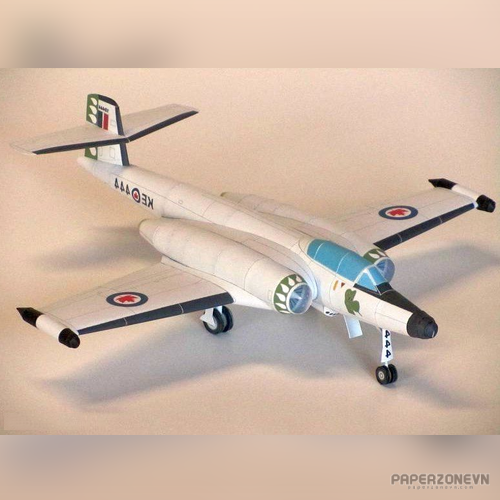- Thumbnail
-

- Resources
- Received from the internet.
- Author
- Unknown.
- Printed File Format
- Page(s)
- 5
- Instruction Format
Avro Canada CF-100 Canuck papercraft
Scale: 1/61
The Avro Canada CF-100 Canuck (affectionately known as the "Clunk") is a Canadian twinjet interceptor/fighter designed and produced by aircraft manufacturer Avro Canada. It has the distinction of being the only Canadian-designed fighter to enter mass production.
Work commenced during October 1946 in response to a Royal Canadian Air Force (RCAF) specification calling for a new jet-powered interceptor/fighter aircraft suitable for long-distance patrol missions and all-weather operations. On 19 January 1950, the CF-100 Mark 1 prototype, 18101, conducted its maiden flight, powered by a pair of Rolls-Royce Avon RA 3 turbojet engines. Both pre-production and production series aircraft were powered by the domestically-developed Avro Orenda engine instead. Flight testing proved the CF-100 to possess a relatively short takeoff run and a high climb rate, making it well suited to its role as an interceptor. On 18 December 1952, Squadron Leader Janusz Żurakowski, the Avro company chief development test pilot, took the CF-100 Mk 4 prototype up to Mach 1.10 in a dive from 14,000 m (45,000 ft),[2] making the type the first straight-winged jet aircraft to achieve controlled supersonic flight

Scale: 1/61
The Avro Canada CF-100 Canuck (affectionately known as the "Clunk") is a Canadian twinjet interceptor/fighter designed and produced by aircraft manufacturer Avro Canada. It has the distinction of being the only Canadian-designed fighter to enter mass production.
Work commenced during October 1946 in response to a Royal Canadian Air Force (RCAF) specification calling for a new jet-powered interceptor/fighter aircraft suitable for long-distance patrol missions and all-weather operations. On 19 January 1950, the CF-100 Mark 1 prototype, 18101, conducted its maiden flight, powered by a pair of Rolls-Royce Avon RA 3 turbojet engines. Both pre-production and production series aircraft were powered by the domestically-developed Avro Orenda engine instead. Flight testing proved the CF-100 to possess a relatively short takeoff run and a high climb rate, making it well suited to its role as an interceptor. On 18 December 1952, Squadron Leader Janusz Żurakowski, the Avro company chief development test pilot, took the CF-100 Mk 4 prototype up to Mach 1.10 in a dive from 14,000 m (45,000 ft),[2] making the type the first straight-winged jet aircraft to achieve controlled supersonic flight

Sponsored: Google Advertising
